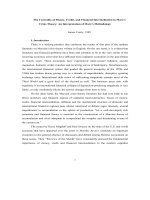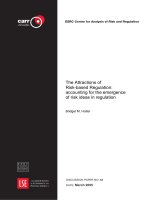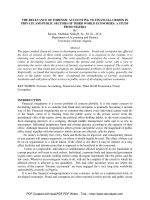The End of Need‐Based Student Financial Aid in Canada? ppt
Bạn đang xem bản rút gọn của tài liệu. Xem và tải ngay bản đầy đủ của tài liệu tại đây (473.81 KB, 55 trang )
TheEndofNeed‐BasedStudent
FinancialAidinCanada?
Preparedfor:
CanadianAssociationofStudentFinancial AidAdministrators(CASFAA)
By
SeanJunorandAlexUsher
August2007
TheEndofNeed‐BasedStudentFi nancialAidinCanada?
EducationalPolicyInstitute 2
About CASFAA
The Canadian Association of Student Financial Aid Administrators (CASFAA) is a national
professional association that represents financial aid administrators at Canada's universities,
colleges and technical institutes. As a professional association, CASFAA serves as a liaison
betweenourmembersandthefederalgovernment,serviceproviders,financialinstitutionsand
various other stakeholders in
student financial aid; advocates on behalf of members by
providinginputonstudentfinancialassistance programsandpolicies;andprovidesprofessional
developmentopportunitiesformembers,includingourannualconference.
About the Educational Policy Institute
TheEducationalPolicy Institute isanon‐profitresearchcenter focusedinissues of educational
opportunity, especially for our most needy populations. Based in VirginiaBeach with offices in
Toronto and Melbourne, EPI conducts program evaluation, policy analysis, and conducts
professionaldevelopmentopportunitiesforeducationalprofessionalsthroughouttheeducation
continuum.VisittheEPIwebsite
atwww.educationalpolicy.org.
About the Authors
SEANJUNORistheManagerofKnowledgeMobilizationattheEducationalPolicyInstitute.Prior
tojoiningtheInstitute,hewastheSeniorPolicyandResearchOfficerfortheCanadaMillennium
Scholarship Foundation. He is a native of Saskatoon, Saskatchewan, and a graduate of the
UniversityofSaskatchewan.(sjunor@educational policy.org
)
ALEX USHER is the Vice‐President of the Educational Policy Institute. Prior to joining the
Institute,hewastheDirectorofResearchandProgramDevelopmentfortheCanadaMillennium
Scholarship Foundation, where he was in charge of Canada’s largest‐ever research project on
access to post‐secondary education. He is
a native of Winnipeg, Manitoba, and graduate of
McGillUniversityandCarletonUniversity.(
)
SuggestedCitation:
Junor, Sean, & Usher, Alex (2007). The End of Need‐Based Student Financial Aid in Canada?
Toronto,ON:EducationalPolicyInstitu te.
TheEndofNeed‐BasedStudentFi nancialAidinCanada?
EducationalPolicyInstitute 3
Table of Contents
AboutCASFAA 2
AbouttheEducationalPolicyInstitute 2
AbouttheAuthors 2
TableofContents 3
DataLimitationsandObservations 4
Chapter1: Introduction 5
Chapter2: StudentAidinCanada1993‐1994to2003‐2004 7
2.1 Introduction 7
2.2
Alberta 8
2.3 BritishColumbia 10
2.4 Manitoba 13
2.5 NewBrunswick 15
2.6 NewfoundlandandLabrador 18
2.7 NovaScotia 20
2.8 Ontario 22
2.9 PrinceEdwardIsland 25
2.10 Québec 27
2.11 Saskatchewan 30
Chapter3: StudentAid
PolicyandProgramChangesSince2004 34
3.1 Introduction 34
3.2 GovernmentofCanadaandCanadaMillenniumSchol arship Foundation 34
3.3 Alberta 37
3.4 BritishColumbia 38
3.5 Manitoba 40
3.6 NewBrunswick 41
3.7 NewfoundlandandLabrador 41
3.8 NovaScotia
42
3.9 Ontario 43
3.10 PrinceEdwardIsland 45
3.11 Québec 45
3.12 Saskatchewan 46
Chapter4 SummaryandConclusions 47
Bibliography 51
AppendixA:TargetedNeed‐BasedStudentAssistance 52
TheEndofNeed‐BasedStudentFi nancialAidinCanada?
EducationalPolicyInstitute 4
Data Limitations and Observations
In order to keep monetary comparisons constant over time, this paper converts all figures in
Chapter2intoJune2005realdollars.
Ineachprovincialsummary,webeginbydisplayingachartshowingchange sinstudentaidover
time.These data show monies extended to students and do not represent
government
expenditures.Whilegovernmentexpendituresandstudenttake‐upisidenticalasfarasgrants,
scholarships,andtaxcreditsareconcerned,theyare notthesamewhenitcomestoloans(the
author’sestimatethecostofadollarofloanstobeabout33cents).
Any interested parties who wish
to investigate or use data behind the tables and figures are
encouragedtocontacttheEducationalPolicyInstitute.
TheEndofNeed‐BasedStudentFi nancialAidinCanada?
EducationalPolicyInstitute 5
Chapter 1: Introduction
TherewasamajorchangeinCanadianstudentaidinthelate1990s,duelargelytoapackageof
measures adopted by the GovernmentCanada as partof its “Canada Opportunities Strategy”.
At the time, what aroused the most comment was the creation in 1998 of the $2.5 billion
Canada Millennium
Scholarship Foundation (Foundation). But while the Foundation was
certainly a welcome – if controversial‐addition to the country’s stock of need‐based aid, its
creationdidnotheraldthestartofanewfocusonneed‐basedaid.Quitethecontrary,infact:
thecreationoftheFoundationwasactually
thelastmajorinvestmentinnee d‐basedaidmade
byanyCanadiangovernmentfornearlysevenyears.
Inretrospect,themostsignificant measureofthelate1990swascontainednottheflashy1998
federal budget, but rather in the almost unheralded budget of 1996. In that budget, the
monthlyeducationtax
creditamountforfull‐timestudentswasincreasedfrom$60permonth
to $80per month.Though it hardly set the world on fire, this measure fundamentally altered
the nature of student aid in Canada. The next year the monthly amount was increased – in
stages – from $80 per
month to$200 per month and part‐time students becameeligible for a
$60 per month credit. These amounts were later doubled in the federal Liberals’ pre‐election
mini‐budget of October 2000, and th en hiked again in 2006 when the new Conservative
governmentcreateda$60permonthtaxcredit
for“textbooks”(morewillbediscussedonthis
inChapter3)whichwasanadditiontotheexistingmonthlyamountinallbutname.Ancillary
fees were added to the tuition fee tax credit. Student loan interest became subject to a tax
creditaswell.
Provinces not to be outdone
got into the tax credit act, too. Most matched the increases in
federal tax credits – some (notably Alberta) increased them way beyond anything the federal
government did. Some have‐not provinces even began trying to use education tax credits as a
waytostemthelossoftheiryouthpopulation.
Whatallofthissignaledwasadecreaseddesireonthepartofgovernmentstouseneed‐based
studentassistancetodistributeaidtothosewhoneeditthemost.Instead,governmentsbegan
finding non‐need‐based methods of providing supports: tax credits, tuition freezes – anything
which did not
use need as a criterion‐became the preferred method of distributing money.
Indeed,governmentswentsofarastobeginactivelyseekingtodistributemoneytopeoplewho
‐sofarfrombeingneedy‐wereactuallywellenoughofftosavesubstantialsumsofmoneyfor
theirchildren’s’education.TheCanada
EducationSavingsGrant(CESG),begunin1998,almost
immediatelybecamea$400‐millionperyearprogram.Recently,provinceshavebeguncopying
this, too – most notably, Québec, which has begun matching federal contributions to the
programona1:2basis.
The metamorphosis from a need‐based system of aid to a
predominantly non‐need‐based
systemofaidinCanadadidnothappeninstantly.Ithasbeentheslow,inexorableresultof an
accretion of government decisions at both the federal and provincial levels. Ideology has not
played a part – governments of both the left and right alike have plunged
with abandon into
non‐need‐basedprojects.
TheEndofNeed‐BasedStudentFi nancialAidinCanada?
EducationalPolicyInstitute 6
Thepurposeofthis report istoshedlightonthe howthissituationevolved, on a province‐by‐
provincebasis
1
.In Chapter 2,the papertakes datafrom 1993‐94 to 2003‐04 (the last yearfor
which good data is available) to show how the mix of available aid changed in each province
over that decade, and how these changes helped to offset the rises in tuition which occurred
overthattime.Thoughtherearesomebroadthemeswhichemergefromthisexamination,the
situation was not the same in all provinces and the individual sections of this chapter should
helpthereaderunderstandthenuancesinsituationsacrossthecountry.
Although gooddata on student assistance is not
available past 2004, it ispossible to track the
broad outline of changes in student aid just by examining various budget documents and
trackinggovernmentannouncementsdealingwithstudentfinancialassistance.Thispaper does
this in Chapter 3. In the final chapter, the paper examines the cumulative effect of these
changes
on student assistance and outlines who has benefited the most from the recent
changes.
1
The authors have not intentional excluded Canada’s three territories from the analysis in the paper,
however, the availability of comparable and quality data does not allow for a full comparison using
territorialdata.
TheEndofNeed‐BasedStudentFi nancialAidinCanada?
EducationalPolicyInstitute 7
Chapter 2: Student Aid in Canada 1993-1994 to 2003-
2004
2.1 Introduction
Chapter 2 de als with changes in the overall amounts of student aid being provided by federal
andprovincialgovernmen tsinbetweentheyears1993‐94and2003‐04,thelastyearforwhich
complete and accurate data is available. It shows the amount of federal and provincial aid
providedbyeach
provinceineachoftheseyears.Italsodescribestheeffectsofthesechanges
on various measures of affordability. Overall, what the chapter shows is that there were very
significant increases in student aid over this decade which, although they did not completely
offset the increases in tuition which occurred
over the course of the 1990s, did go some
considerabledistancetomitigatingit.
The data in this chapter are largely based on two EPI publications; The State of Student Aid in
Canada(2007,forthcoming)andBeyondtheStickerPrice(2006).Dataonfederalandprovincial
expenditureswasdirectlycollectedin
twosurveys–oneconductedin2003and2004aspartof
thePrice ofKnowledge 2004 project andanotherin early2005 aspart ofThe State of Student
Aid. Data shown in the various figures has been expressed in real 2005 dollars in order to
accountforinflation.
Inallfigures,theportionindicatedas“netloans”referstotheamountof
loans issued minus the amount of remission paid out (to avoid double counting) in any given
year.Thisshouldnotbetakenasreflectiveofactualgovernmentexpendituresonloans;though
the figure varies somewhat over
time and across provinces, as a rule of thumb, a dollar in
student loans costs a government roughly 33 cents in interest carrying charges, defaults, and
interestreliefcosts.
Thedataonindividualaffordabilityispresentedasfollows:Foreachprovinceineachyear,data
ispresentedonthefollowingfour
concepts:
Average Tuition
2
and fees: Average tuition for undergraduate
3
students plus average ancillar y
feesasreportedbyStatisticsCanada
Tax Credits: Tax credits available to students studying full‐time for eight months paying the
averagetuitionandfeeslistedabove.
Everybody’sNetTuition(ENT).Averagetuitionandfeesminustaxcredits:ineffect,thetuition
chargeminusthe
non‐repayabletaxcreditswhicheveryonereceives.
2
StatisticsCanadadoesnotproducetuitionandfeedatanordoestheagencydisaggregatebypolytechnic
oruniversity‐college.
3
Undergraduate tuitionfee numbersare weightedaveragescalculated using themost current
enrolment data available and the following faculties are included: Agriculture, Architecture,
Arts, Commerce, Dentistry, Education, Engineering, Household Science, Law, Medicine, Music,
andScience.
TheEndofNeed‐BasedStudentFi nancialAidinCanada?
EducationalPolicyInstitute 8
AverageGrants:Theaveragesizeofgrantinaparticularjurisdictioninaparticularyear.
Grant Recipients’ Net Tuition (GRNT): NET minus average grants. In effect, the “net” tuition
paidbythosepeoplewhoreceivegrants.
2.2 Alberta
StudentAssistanceExpendituresto2004
Total student assistance available to students in Alberta rose by close to 80 percent over the
decadeto2003‐04;substantiallymorethanthenationalaverageof50percent.Atthestartof
thedecade,annualexpenditureswerejustover$400million peryear;by2003
‐04,expenditures
wereroughly$725million.Over halfofthisincreasewasduetoanincreaseintaxexpenditures;
mostoftheremainderisduetoanincreaseingrantsandloanremission.Together,thismeans
alloftheincreaseinassistancehasbeenduetoanincreaseinnon‐
repayableassistance;indeed,
netloansnowonlycoveraboutone‐thirdoftotalassistanceinAlberta.
In part, this increase was due to an increase in the number of post‐secondary students in the
province: college and uni versity enrolments rose by 20 to 25 percent during the decade in
question. Still,
real aid available to student grew substantially over the decade.Total aid
availabletostudentsisshownbelowinFigure1.
Figure1–TotalAssistancebyType–Alberta($2005)
0
100
200
300
400
500
600
700
800
1993-
94
1994-
95
1995-
96
1996-
97
1997-
98
1998-
99
1999-
00
2000-
01
2001-
02
2002-
03
2003-
04
$ Millions
Tax Expenditures CESG Mer it Net Loans Remission Grants
Asintherestofthecountry,thedecadeendedwithproportionatelylessassistancebeinggiven
outbytheprovincialgovernmentthanatthestart.Althoughprovincialaidincreasedbyroughly
$50 million, federal aid more than doubled, from $214 million to $478 million.As a result,
nearlytwo‐thirds
ofallstudentaiddollarsinAlberta(need‐basedanduniversalcombined)now
comefromtheGovernmentofCanada.
TheEndofNeed‐BasedStudentFi nancialAidinCanada?
EducationalPolicyInstitute 9
Figure2–TotalAssistancebySource–Alberta($2005)
0
100
200
300
400
500
600
700
800
1993-
94
1994-
95
1995-
96
1996-
97
1997-
98
1998-
99
1999-
00
2000-
01
2001-
02
2002-
03
2003-
04
$ Millions
Government of Alberta MSF Government of Canada
AffordabilityOutcomes:NetTuitioninAlbertaoverTime
To date, the paper has been examining changes in government expenditure levels.But how
have these changes affected individual students?In order to answer this, the paper will
examinechangesintuitio n,taxcreditsandgrants.ThisisdonebelowinTable
1.
Table1–ChangesinTuition,SubsidiesandNetCosts,Alberta1995‐96to2005‐06(real$2005
dollars)
Tuitionand
Fees
Tax
Credits ENT Grants GRNT
1995‐96 $3,819 $1,103 $2,716 $3,397‐$681
1996‐97 $4,072 $1,166 $2,907 $3,388‐$481
1997‐98 $4,345 $1,233 $3,112 $3,163‐$51
1998‐99 $4,666 $1,338 $3,328 $3,479‐$152
1999‐00 $4,804 $1,470 $3,334 $2,888 $447
2000‐01 $4,875 $1,843 $3,031 $2,652 $379
2001‐02 $4,874 $1,843 $3,031 $2,424 $607
2002‐03 $4,963 $2,134 $2,829 $2,874‐$44
2003‐04 $5,234 $2,208 $3,026 $2,733 $293
2004‐05 $5,606 $2,326 $3,281
2005‐06 $5,638 $2,334 $3,304
Tuitionandfeesrosesteadilyformuchofthe decadeinquestion.Overall,tuitionfeesroseby
justover$1,800.However,federalandprovincialtaxcreditsoffsetmorethanhalfthisgrowth.
Once the effects of tax credits are taken into account, the net tuition paid by Alberta student
only
increasedby$600,orabout22percent.
TheEndofNeed‐BasedStudentFi nancialAidinCanada?
EducationalPolicyInstitute 10
The average grant size decreased by about $600 in the period, meaning that Grant recipients’
net tuition (GRNT) rose substantially after 1998‐99.However, because of data collection
limitations,GRNTis basedontheaveragegrantsize,
nottheaverageamount ofgrantreceived
(individuals can receive more than one grant).Since the number of grants increased
substantially over the years in question (from 13,807 in 1998‐99 to 34,954 in 1999‐2000 and
54,564in2003‐04),itseemslikelythat notonlyarea larger
peoplearereceivinggrants,butthat
more people are receiving multiple grants as well, meaning that “true” GRNT is probably
decreasing,notincreasing.
In other words, combined federal and provincial expenditures have kept rises in net tuition to
about 20 percent which – given the increases in family income in Alberta
over these years –
means they have stayed roughly constant in terms of affordability.The picture for grant
recipients’ net tuition is a little less clear, but given the sharp increasein the number of grant
recipients,itseemslikelythatoverall,the affordability picturehasimprovedsubstantiallyfora
largenumberofstudentsintheprovince.
2.3 British Columbia
StudentAssistanceExpendituresto2004
TotalstudentassistanceexpendituresinBritishColumbiamorethandoubledoverthedecadeto
2003‐04;substantiallymorethanthenationalaverageof50percent.Atthestartofthedecade,
annual expenditures were $430 million per year; by 2003‐04, expenditures were roughly $900
million
per year.Over half of this increasewas due to anincrease in need‐based loans, and a
substantial portion of the remainder came from need‐based grants.In significant contrast to
mostotherprovinces,lessthan20percentoftheincreaseinassistanceinBritishColumbiacame
fromtax
creditsandonlyaboutathirdcamefromuniversalsourcesofincome.
Much of the increase in student aid in British Columbia can be attributed to the province’s
spectacular growth in post‐secondary education participation (albeit from a very low base)
duringthe decade in question.However,evenwithstudent numbers
increasingby roughly 50
percent, the growth in student aid dollars was such that per‐student aid still increased
substantially.
TheEndofNeed‐BasedStudentFi nancialAidinCanada?
EducationalPolicyInstitute 11
Figure4–TotalAssistancebyType–BritishColumbia($2005)
0
100
200
300
400
500
600
700
800
900
1000
1993-
94
1994-
95
1995-
96
1996-
97
1997-
98
1998-
99
1999-
00
2000-
01
2001-
02
2002-
03
2003-
04
$ Millions
Tax CESG Mer it Loans Remission Grants
As in most other provinces, the distribution of student assistance by source changes
substantially during this decade.At the outset of the decade, roughly 45 percent of all aid in
British Columbia came from the provincial government; by 2003‐04, this proportion had fallen
to less than 32 percent, thanks
to a 140 percent rise in federal loans, grants and tax credits
combined.Thisisnottosay provincialassistancedeclined;indeed,inabsoluteterms,provincial
assistanceincreasedsubstantiallyfrom$190millionperyearto$288millionperyear.Butthe
hugeincreaseinfederalaidsimplyoutstrippedthegrowthin
provincialaid.
TheEndofNeed‐BasedStudentFi nancialAidinCanada?
EducationalPolicyInstitute 12
Figure4–TotalAssistancebySource–BritishColumbia($2005)
0
100
200
300
400
500
600
700
800
900
1000
1993-
94
1994-
95
1995-
96
1996-
97
1997-
98
1998-
99
1999-
00
2000-
01
2001-
02
2002-
03
2003-
04
$ Millions
Government of British Columbia MSF Government of Canada
AffordabilityOutcomes:NetTuitioninBritishColumbiaoverTime
To date, this paper has been e xamining changes in government expenditure levels.But how
have these changes affected individual students?In order to answer this, the paper needs to
examinechangesintuitio n,taxcreditsandgrants.Thisisdonebelow
inTable2.
Table2–ChangesinTuition,SubsidiesandNetCosts,BritishColumbia,1995‐96to2005‐06
Tuition
andFees
Tax
Credits ENT Grants GRNT
1995‐96 $3,433 $1,053 $2,381 $3,286‐$905
1996‐97 $3,419 $1,049 $2,370 $3,797‐$1,427
1997‐98 $3,312 $1,014 $2,297 $3,626‐$1,329
1998‐99 $3,273 $1,042 $2,231 $3,246‐$1,015
1999‐00 $3,242 $1,129 $2,113 $3,086‐$973
2000‐01 $3,315 $1,081 $2,234 $3,317‐$1,083
2001‐02 $3,136 $1,051 $2,085 $3,399‐$1,314
2002‐03 $3,870 $1,429 $2,442 $2,890‐$448
2003‐04 $4,909 $1,584 $3,325 $2,807 $519
2004‐05 $5,458 $1,716 $3,742
2005‐06 $5,349 $1,762 $3,587
Due to the provincial tuition freeze in the period 1996‐2002, tuition, net tuition and GRNT
remained more or less constant over those years.However, as noted earlier, GRNT only tells
part of the story; equally important was the fact that the number of grants more than tripled
overthe
sameperiod,increasingfrom14,878in95‐96to54,919in2001‐02.Asaresult,inthe
period up to 2002, the situation remained constant for both non‐grant recipients and grant
recipients,buttheoverallaffordabilitypositionimprovedasmorestudentsreceivedgrants.
TheEndofNeed‐BasedStudentFi nancialAidinCanada?
EducationalPolicyInstitute 13
Thissituationchangedwhentheprovincialgovernmentdecidedtoliftthetuitionfeefreeze and
allowfeestorisebyroughly60percent,from$3,136in2001‐02to$5,458in2004‐05.Although
taxcreditsau tomatically
rosetopartiallyoffsettheincrease,ENTstillrosebyover80percentin
thethree yearsafter the tuition fee increase.As for grantrecipients, their numbers remained
constantbuttheaveragesizeoftheirgrantactuallydeclined.Asaresult,theywentfrompaying
substantiallynegativetuitionto
payingabout$500innettuition.
In sum, after enjoying a very good last half of the 1990s in which net costs actually declined,
BritishColumbiastudents’financialpositiondeterioratedrapidly inthefirsthal f ofthisdecade.
2.4 Manitoba
StudentAssistanceExpendituresto2004
Total student assistance expenditures in Mani toba rose by about 80 percent.This is
substantially more than the national average of 50 percent, but less than that in some of the
otherwesternprovinces.Atthestartofthedecade,annualexpenditureswere$92millionper
year;
by 2003‐04, expenditureswere roughly$166 millionperyear.Noneof this increasewas
dueto arise innetloans –indeed, these declinedover thedecade.Mostof theincreasewas
due to an expansion in tax credits but a not insubstantial portio n of the rise was
due to the
introduction of remission programs the province and the Canada Millennium Scholarship
Foundation.
Some of this rise in total assistance was due to changes in post‐secondary education studen t
numbers, which rose by roughly 25 percent in the years after 1999; however, the growth in
student aid still outstripped
the growth in student numbers substantially, implying that per‐
studentaidrosesubstantially.
Figure5–TotalAssistancebyType–Manitoba($2005)
0
20
40
60
80
100
120
140
160
180
1993-
94
1994-
95
1995-
96
1996-
97
1997-
98
1998-
99
1999-
00
2000-
01
2001-
02
2002-
03
2003-
04
$ Millions
Tax CESG Mer it Net Loans Remission Grants MSRFA P
TheEndofNeed‐BasedStudentFi nancialAidinCanada?
EducationalPolicyInstitute 14
As in most other provinces, the distribution of student assistance by source changed
substantially during this decade.At the outset of the decade, roughly 25 percent of all aid in
Manitoba came from the provincial government; by
1996‐1997 this had risen to over 40
percent.However,startingin1998‐99(thatis,aftertheCanadaOpportunitiesBudgetof1998),
theproportioncoming fromtheprovincial governmentbeganto fallquitesignificantly, so that
by2001‐02,thisproportionhadfallenbackto22percentwhereit
remainstoday.Thischange
inproportionwasnot–asitwasinsomeprovinces‐simplyamatterofthegrowthinfederalaid
outstripping growth in provincial aid.In Manitoba, provincial aid actually declined, although a
muchlargerproportionwasnowgivenoutingrantratherthanloan.
Figure
6–TotalAssistancebySource–Manitoba($2005)
0
20
40
60
80
100
120
140
160
180
1993-
94
1994-
95
1995-
96
1996-
97
1997-
98
1998-
99
1999-
00
2000-
01
2001-
02
2002-
03
2003-
04
$ Millions
Government of Manitoba MSF Government of Canada
AffordabilityOutcomes:NetTuitioninManitobaoverTime
To date, this paper has been e xamining changes in government expenditure levels.But how
have these changes affected individual students?In order to answer this, this paper needs to
examinechangesintuitio n,taxcreditsandgrants.Thisisdonebelowin
Table3.
TheEndofNeed‐BasedStudentFi nancialAidinCanada?
EducationalPolicyInstitute 15
Table 3 – Changes in Tuition, Subsidies and Net Costs, Manitoba, 1995‐96 to 2005‐06 ($2005
realdollars)
Tuition
andFees
Tax
Credits ENT Grants GRNT
1995‐96 $3,479 $1,064 $2,414 $2,956‐$541
1996‐97 $3,665 $1,112 $2,552 $2,991‐$438
1997‐98 $3,903 $1,174 $2,729 $4,145‐$1,416
1998‐99 $4,133 $1,266 $2,867 $2,372 $495
1999‐00 $4,510 $1,456 $3,054 $2,967 $87
2000‐01 $4,003 $1,682 $2,322 $3,126‐$804
2001‐02 $3,965 $1,671 $2,293 $3,146‐$853
2002‐03 $3,918 $1,915 $2,004 $3,217‐$1,214
2003‐04 $3,874 $1,903 $1,971 $2,710‐$738
2004‐05 $3,982 $1,932 $2,050
2005‐06 $4,031 $1,945 $2,086
Intheperiodpriortothe1999tuitionfreeze,nettuitionincreaseforgrantrecipientsandnon‐
grant recipients alike grew by about $600.Subsequently, the 10 percent roll‐back and
subsequent freeze, combined with generous increases in governmental education tax credits,
sawasubstantialoveralldeclineinrealcosts.
Indeed,ENTdeclinedbyalmost$1,000(nearly33
percent)between1999‐2000.Thus,studentsin2005‐06paidlessinrealdollarsthantheydida
decadeearlier,andsubstantiallylessth antheydidin1999‐00.
2.5 New Brunswick
StudentAssistanceExpendituresto2004
TotalstudentassistanceexpendituresinNewBrunswickincreasedby84percentinthedecade
to2003‐04,substantiallymorethanthenationalaverageincreaseof50percent.Atthestartof
the decade, annual expenditures were $115 million per year; by 2003‐04, expenditures were
roughly
$219 million per year.Roughly half of this increase was due to an increase in need‐
based loans; most of the remainder was due to an increasein universal assistance, mainly tax
benefits.
Very little of this increase can be attributed to growing post‐secondary education student
numbers.Thetotal
increaseincollegeanduniversitystudentsoverthedecadeinquestionwas
betweentenand15percent;asaresult,per‐studentfundingincreasedbywellover50percent.
TheEndofNeed‐BasedStudentFi nancialAidinCanada?
EducationalPolicyInstitute 16
Figure7–TotalAssistancebyType–NewBrunswick($2005)
-
50
100
150
200
250
1993-
94
1994-
95
1995-
96
1996-
97
1997-
98
1998-
99
1999-
00
2000-
01
2001-
02
2002-
03
2003-
04
$ Millions
Tax CESG Net Loans Remission Grants Merit
The distribution of student assistance by source fluctuated somewhat over the course of the
decade.For the most part, the federal share of total aid stayed between 60 and 70 percent;
however, in three anomalous years (1994‐95, 1995‐96 and 1998‐99), this share fell below 60
percent.This
isnottosaythatprovincialassistancefell;indeed,inabsolute terms,itincreased
bynearly75percent,fro m$40millionto$69million.However,thiswasonlybarelyenoughto
keepupwiththerapidincreaseinfederalaidwhichwasoccurringthroughoutthedecade.
Figure8–TotalAssistance
bySource–NewBrunswick($2005)
-
50
100
150
200
250
1993-
94
1994-
95
1995-
96
1996-
97
1997-
98
1998-
99
1999-
00
2000-
01
2001-
02
2002-
03
2003-
04
Government of New Brunswick MSF Government of Canada
TheEndofNeed‐BasedStudentFi nancialAidinCanada?
EducationalPolicyInstitute 17
AffordabilityOutcomes:NetTuitioninNewBrunswickoverTime
To date, the paper has been examining changes in government expenditure levels.But how
have these changes affected individual students?In order to answer this, the paper needs
to
examinechangesintuitio n,taxcreditsandgrants.Thisisdonebelowintable4.
Table4–ChangesinTuition,SubsidiesandNetCosts,NewBrunswick,1995‐96to2005‐06
Tuition
andFees
Tax
Credits ENT Grants GRNT
1995‐96 $3,369 $1,118 $2,251 $734 $1,517
1996‐97 $3,652 $1,197 $2,455 $904 $1,551
1997‐98 $3,833 $1,239 $2,593 $882 $1,711
1998‐99 $4,046 $1,326 $2,719 $958 $1,761
1999‐00 $4,092 $1,439 $2,653 $1,267 $1,386
2000‐01 $4,231 $1,652 $2,579 $1,823 $755
2001‐02 $4,442 $1,706 $2,735 $1,655 $1,080
2002‐03 $4,735 $2,038 $2,697 $1,631 $1,067
2003‐04 $4,935 $2,089 $2,846 $2,108 $738
2004‐05 $5,124 $2,138 $2,986
2005‐06 $5,323 $2,189 $3,134
New Brunswick is one of the very few provinces that did not implement some kin d of tuition
freeze over the past decade.As a result, tuition rose by $2,000 (or about 58 percent) in the
decadeto2005‐06.Thegrowthintaxcreditspartiallyoffsetthisincrease,asthe
valueofthese
credits increased by about $1,070 per student over the decade.As a result, ENT grew more
slowly,byonlyabout$900.
Students who received grants, however, were in a different situation.The average grant size
rose dramatically over the decade, notably when the Canada Mille nnium Scholarship
Foundation bursaries
were introduced in 1999‐2000 and when the province increased its own
bursaryprogramin2003.Thegrowthingrantsmorethanoffsetanygrowthinnettuition–asa
result, students whorece ive grants in New Brunswick now pay substantially less than they did
tenyearsago.Moreover,
therearesubstantiallymoregrantrecipientsnowthantherewerea
decade ago.This means that affordability in the province has improved significantly among
high‐needstudentsoverthecourseofthedecade.
TheEndofNeed‐BasedStudentFi nancialAidinCanada?
EducationalPolicyInstitute 18
2.6 Newfoundland and Labrador
StudentAssistanceExpendituresto2004
Total student assistance expenditures in Newfoundland and Labrador in 2003‐4 were $154
million,some60percentmorethantheyhadbeenadecadeearlier.Thisisroughlysimilartothe
national average of a 50 percent increase over the course of the decade. Yet assistance
had
been much higher five years earlier in 1998‐99, total student aid spending had been $217
million,ormorethanoftheotherwesternprovinces.Nearlyalloftheincreaseinassistance‐up
to 1997‐98‐came in the form of loans.After that, loans declined precipitously, but this
was
partiallyoffsetbyasignificantriseintuitiontaxcredits.
This growth in student aid has occurred in a context where post‐secondary education student
numbers were falling more or less in line with the decline in the provincial youth population
throughout the late 1990s.Enrolments then bounced back again
around the turn of the
millenniumandasaresult,thetotalenrolmentincreaseoverthedecadewasabouttenpercent.
Thisimpliesthatper‐studentaidwasuproughly40percentoverthecourseofthedecade.
Figure9–TotalAssistancebyType–Newfoundland&Labrador($2005)
0
50
100
150
200
250
1993-94 1994-95 1995-96 1996-97 1997-98 1998-99 1999-00 2000-01 2001-02 2002-03 2003-04
$ Millions
CESG Tax Mer it Net Loans Remission Grants
At the start of the decade in question, roughly 30 percent of all student assistance in
Newfoundland and Labrador came from the provincial government.This rose to roughly 40
percent by 1998‐99.Then, as federal governmen t expen ditures increased following the 1 998
budgetandprovincialloanpaymentsdeclinedasprivate
vocationalcollegeswereremovedfrom
thestudent aidrolls,the province’sshare oftotal assistancehas sincedeclinedagain to about
30percent.
TheEndofNeed‐BasedStudentFi nancialAidinCanada?
EducationalPolicyInstitute 19
Figure10–TotalAssistancebySource–Newfoundland&Labrador($2005)
-
50
100
150
200
250
1993-94 1994-95 1995-96 1996-97 1997-98 1998-99 1999-00 2000-01 2001-02 2002-03 2003-04
$ Millions
Government of New foundland MSF Government of Canada
AffordabilityOutcomes:NetTuitioninNewfoundlandandLabradoroverTime
To date, this paper has been e xamining changes in government expenditure levels.But how
have these changes affected individual students?In order to answer this, the paper needs to
examinechangesintuitio n,taxcreditsandgrants.Thisisdone
belowinTable5.
Table5–ChangesinTuition,SubsidiesandNetCosts,NewfoundlandandLabrador,1995‐96to
2005‐06
Tuition
andFees
Tax
Credits ENT Grants GRNT
1995‐96 $3,101 $1,075 $2,026 $1,410 $616
1996‐97 $3,530 $1,244 $2,286 $2,918‐$632
1997‐98 $4,085 $1,518 $2,567 $2,531 $36
1998‐99 $4,215 $1,671 $2,544 $2,032 $513
1999‐00 $4,324 $1,702 $2,622 $2,372 $249
2000‐01 $4,623 $1,910 $2,714 $2,827‐$114
2001‐02 $4,134 $1,780 $2,355 $2,891‐$536
2002‐03 $3,413 $1,588 $1,825 $3,027‐$1,202
2003‐04 $3,216 $1,536 $1,680 $2,571‐$891
2004‐05 $3,164 $1,522 $1,642
2005‐06 $3,070 $1,497 $1,573
TuitionandfeesroseinNewfoundlandandLabradoroverthelatterhalfofthe1990s.However,
theprovincialgovernment’sdecisiontorollbacktuitionandthenfreezeitreducedcostsinreal
dollarsbyathirdfrom2000‐01to2005‐6(andbeyond).Thevalueoftaxcreditsfell
duringthis
TheEndofNeed‐BasedStudentFi nancialAidinCanada?
EducationalPolicyInstitute 20
period(anaturalresultofthetuitionreductionsincecreditsarebasedinpartonpaidfees),but
ENTstillfellby$1,200,orjustover40percent.FluctuationsinaveragegrantsmeantthatGRNT
felltoo.
Allstudentsthereforebenefitedfrommoreaffordableeducationcosts.
2.7 Nova Scotia
StudentAssistanceExpendituresto2004
Overthedecadefrom1993‐94to2003‐04,assistancetoNovaScotiastudentsrosebyjustover
50percent‐thatis,roughlyequaltothenationalaverage–from$143millionperyearto$ 233
million per year.The rise was caused by a number
of things – growth in net loans, growth in
remissionprograms,growthintaxcredits,growthinCESGsandgrowthingrants.Indeed,Nova
Scotia is unusual in having growth across all financial instruments.Proportionately, though,it
wastaxcreditsthatrosethefastestofallinstrumentsandaccountedfor
approximatelyhalfthe
riseintotalassistance.
Notallofthisgrowthtranslatedintoincreasedamountsofdollarsperstudent.Overallcollege
and university enrolment in Nova Scotia rose by 20 percent, meaning that per‐student aid
actuallyonlyincreasedbyabout25percent.
Figure11–TotalAssistancebyType
–NovaScotia($2005)
0
50
100
150
200
250
1993-94 1994-95 1995-96 1996-97 1997-98 1998-99 1999-00 2000-01 2001-02 2002-03 2003-04
$ Millions
Tax CESG Mer it Net Loans Remission Grants
Interms of thesource of assistance, atthestart ofthedecade in question,thegovernment of
NovaScotiawasresponsibleforover45percentoftotalassistancedistributedintheprovince.
This proportion remained more or less constant until 1998, when two things happened.First,
federalexpendituresbegan
toriseasaresultofthe1998budget,andsecond,halftheprovincial
TheEndofNeed‐BasedStudentFi nancialAidinCanada?
EducationalPolicyInstitute 21
student loan client base suddenly disappeared
4
.The provincial share of total assistance then
droppedprecipitouslytoabout25percent,whereitremainstoday.
Figure12–TotalAssistancebySource–NovaScotia($2005)
0
50
100
150
200
250
300
1993-94 1994-95 1995-96 1996-97 1997-98 1998-99 1999-00 2000-01 2001-02 2002-03 2003-04
$ Millions
Government of Nova Scotia MSF Government of Canada
AffordabilityOutcomes:NetTuitioninNovaScotiaoverTime
To date, this paper has been e xamining changes in government expenditure levels.But how
have these changes affected individual students?In order to answer this, the paper needs to
examinechangesintuitio n,taxcreditsandgrants.Thisisdonebelow
intable6.
4
Between1997/98and1998/99,theGovernmentofNovaScotiamanagedtoreduceitsownstudentloan
rolls by nearly 50 percent in a single year. Clearly, this reduction had nothing to do with a general
reduction in the need for loans – indeed, the Canada Student Loans clientele remained effectively
unchangedduringthisperiod.Ineffect,thegovernmentofNovaScotiatweakeditsowneligibilitycriteria
inordertoreduceitsexposuretostudentloansatatimewhentheprogramwasfacedwithsomeserious
financialpressure.
TheEndofNeed‐BasedStudentFi nancialAidinCanada?
EducationalPolicyInstitute 22
Table6–ChangesinTuition,SubsidiesandNetCosts,NovaScotia,1995‐96to2005‐06
Tuition
andFees
Tax
credits ENT Grants GRNT
1995‐96 $4,279 $1,334 $2,945 $643 $2,303
1996‐97 $4,633 $1,430 $3,203 $1,612 $1,591
1997‐98 $4,949 $1,506 $3,443 $3,078 $365
1998‐99 $5,133 $1,589 $3,545 $4,447‐$903
1999‐00 $5,282 $1,736 $3,547 $2,324 $1,223
2000‐01 $5,584 $1,851 $3,732 $2,422 $1,310
2001‐02 $5,824 $1,913 $3,911 $2,397 $1,514
2002‐03 $6,084 $2,236 $3,848 $2,795 $1,052
2003‐04 $6,357 $2,307 $4,051 $3,622 $429
2004‐05 $6,777 $2,415 $4,363
2005‐06 $6,820 $2,426 $4,394
NovaScotiastudentspaythehighestuniversitytuitionfeesinthecountry;inconsequence,they
also receive the largest amounts of tax credi ts on the country.The rise in tax credits has
partially,butbynomeansfully,offsettheincreaseintuition:ENTroseby$1,450(ornearly50
percent) over the decade.For grant recipients, however, it is a different story.The average
grantsizefluctuatedconsiderablyoverthedecade,butingeneralgrantsincreasedsubstantially
meaningstudentswhoreceivedgrantswere,inthemain,muchbetteroffin2003‐04thanthey
were in 1995‐96.As the
number of grants did not decrease (they actually increased slightly,
althoughthesourceswitchedfrom primarilyprovincialtoprimarilyMillenniumBursaries),what
this means is that – in contrast to the average non‐grant‐recipient‐the average position of
grantrecipientsimprovedsubstantially.
2.8 Ontario
StudentAssistanceExpendituresto2004
TotalstudentassistanceexpendituresinOntarioincreasedby39percentbetween1993‐94and
2003‐04, somewhat less that the national average increase of 50 percent.At the start of the
decade of analysis, annual expenditures were $1.7 billion per year; by 2003‐04, expenditures
were
roughly$2.45billionperyear.Justover100percentoftheincreasecamefromuniversal
assistance sources (need‐based sources actually decreased over the decade), and roughly 70
percent of the increase in universal assistance came through tax‐based sources.Figur e 13
showstotalassistanceavailabletoOntariostudents.
Ontario’s
below‐average performance is even more pronounced when changes in post‐
secondaryeducationstudentpopulationaretakenintoaccount.Evenbeforethedoublecohort,
enrolmentwas up15 percent‐withthe double cohort, the increase was closer to 30percent,
meaningthatper‐studentassistancelevelsroseonlyminimally.
TheEndofNeed‐BasedStudentFi nancialAidinCanada?
EducationalPolicyInstitute 23
Figure13–TotalAssistancebyType–Ontario($2005)
-
500
1,000
1,500
2,000
2,500
3,000
1993-
94
1994-
95
1995-
96
1996-
97
1997-
98
1998-
99
1999-
00
2000-
01
2001-
02
2002-
03
2003-
04
$ Millions
Tax CESG Merit Net Loans Remission Grants
Whenlookingat assistance bysource, weseea familiarpattern.At thestart ofthede cadein
question,theprovincialgovernmentwasresponsibleforsomethingverycloseto50percentof
allassistance.Thoughincreasingfederalaid(primarilyloanaid)dilutedthissomewhatoverthe
nextfive years,the
provincialsources ofassistance continuedtorise inabsolute terms.Then,
after1998,thingschangedconsiderably.Federalsourcesofassistancebegantoriserapidly(as
aresultofthe1998federalbudget)andprovincialsourcesbegantodecline(becauseofchanges
to its loan program).By 2000‐01, the provincial share
of assistance had dropped to below 30
percent,whereitremains today.Provincialassistance fell inbothabsoluteandrelativeterms;
in2003‐04,Ontarioassistanceamountedto$671million,comparedto$849millionin1993‐94,
and$1,147millionin1997‐98.
TheEndofNeed‐BasedStudentFi nancialAidinCanada?
EducationalPolicyInstitute 24
Figure14–TotalAssistancebySource–Ontario($2005)
0
500
1000
1500
2000
2500
3000
1993-94 1994-95 1995-96 1996-97 1997-98 1998-99 1999-00 2000-01 2001-02 2002-03 2003-04
$ Millions
Government of Ontario MSF Government of Canada
AffordabilityOutcomes:NetTuitioninOntariooverTime
To date, this paper has been e xamining changes in government expenditure levels.But how
have these changes affected individual students?In order to answer this, the paper needs to
examinechangesintuitio n,taxcreditsandgrants.Thisisdonebelowin
Table7.
Table7–ChangesinTuition,SubsidiesandNetCosts,Ontario,1995‐96to2005‐06
Tuition
andFees
Tax
Credits ENT Grants GRNT
1995‐96 $3,684 $1,147 $2,537 $3,773‐$1,236
1996‐97 $4,151 $1,271 $2,881 $3,527‐$647
1997‐98 $4,466 $1,293 $3,172 $4,861‐$1,689
1998‐99 $4,873 $1,398 $3,475 $5,973‐$2,499
1999‐00 $5,386 $1,573 $3,813 $4,681‐$868
2000‐01 $5,384 $1,637 $3,747 $3,698 $49
2001‐02 $5,552 $1,681 $3,871 $2,283 $1,588
2002‐03 $5,602 $1,951 $3,651 $1,823 $1,828
2003‐04 $5,794 $1,999 $3,795 $2,599 $1,196
2004‐05 $5,690 $1,976 $3,714
2005‐06 $5,586 $1,953 $3,633
Tuitionfeesrosesubstantia llyinrealdollarsinthelate1990sbeforeslowingatthe turnofthe
decade and actually falling after 2003‐04 and the imposition of a two‐year tuition freeze.As
elsewhere,theincrease in tuitioncredits partiallyoffsetthe riseinfees, but ENTstill
increases
by$1,100,orabout43percentinrealterms.
TheEndofNeed‐BasedStudentFi nancialAidinCanada?
EducationalPolicyInstitute 25
Withrespecttonettuitionchargesforgrantrecipients,thepictureissomewhatmorenuanced.
Thevastreductionintheprovince’sloanremissionschemetowardstheendofthe1990smeant
thatgrantrecipientsonaveragereceived
substantiallylessthanthey previouslydid,andGRNT
rose.However, the number of grants issued rose substantially over the decade.What this
means is that people who would have received grants in 1995‐96 were noticeably worse off a
decadelater,butatthesametimetherewerealarge
numberofnewgrantrecipientswhowere
betteroff.
2.9 Prince Edward Island
StudentAssistanceExpendituresto2004
Overthedecadefrom1993‐94to2003‐04,assistancetoIslandstudentsnearlytripledfrom$15
million to $43 million annually. This is much higher than was the case nationally, where the
averageincreasewasonly50percent.Allformsofassistanceincreasedinvalue–thoughnearly
allthenetincreasecanbeattributedtotheincreasesinnetloans(189percent)andtaxcredits
(up 275 percent).This impressive rise in assistance was only slightly offset by the 25 percent
increaseinenrolments
Figure15–TotalAssistancebyType–PEI($2005)
0
5
10
15
20
25
30
35
40
45
1993-94 1994-95 1995-96 1996-97 1997-98 1998-99 1999-00 2000-01 2001-02 2002-03 2003-04
$ Millions
Tax CESG Merit Net Loans Remission Residency-Based Aw ards Grants
In terms of the source of assistance, at the start of the decade in question, the provincial
governmentwasresponsibleforonlyabout26percentoftotalassistanceprovidedtostudents.
That figure grew after the introduction of the Island Student Loan Program, but then declined
again after the changes
resulting from the 1998 federal budget.Overall, the provincial
government accounts for 30 percent of all assistance delivered in the province, making it the









